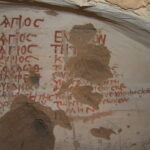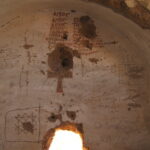| Artefact ID | 700 |
| TM ID | TM 102987 + 102988 |
| Findspot (DEChriM ID) | 15 (al-Baǧawāt) | Class | Textual |
| Material | Plaster |
| Writing medium | Dipinto |
| Text content | Subliterary |
| Language | Greek |
| Description | I.Oasis p. 70-71 no. 13; IGChrEg 354; SEG XXXVIII 1710: trishagion and prayer. On the east wall, painted in red, in two columns, a funerary inscription for a woman, perhaps named Tetouis and her sons (Wagner 1987: 70). The first column is centred right above a large crux ansata located in the middle of the wall and painted in the same colour. It bears part of the Sanctus of the early Egyptian anaphora drawing on Isa. 6:3, "Holy, holy, holy, Lord of Sabaoth; heaven and earth are full of your glory" (see parallel in the 4th c. Euchologium of Montserrat, including the anaphora). Another column was added to the right, the first two lines of which are in the same kind of square majuscule hand as in the first one (see also the legends in the Chapel of Peace, in Chapel 25, I.Oasis p. 69 no. 12 or the presbyteral blessing of Dayr al-Baǧawāt). These lines contain an invocatio to the "Lord almighty" to have mercy on the deceased woman. More lines, written in a round informal hand with a few ligatures, were added afterwards in this second column and integrate to the prayer the mention of her deceased sons who must have died later (with echo to Ps. 16.8). On the north wall of the same chapel (facing the entrance) I.Oasis p. 69 no. 12 and, outside, I.Oasis p. 69 no. 11. |
| Selection criteria | Subliterary genre (Liturgical), Christian symbols/gestures/isopsephy, Biblical quote or paraphrase, Archaeological context associated with Christian markers |
| Date from | 400 |
| Date to | 499 |
| Dating criteria | Archaeological context. Probably written later than I.Oasis p. 69 no. 12 (Cipriano 2003: 277). |
| Absolute/relative date | Relative date |
| Archaeological context | Chapel no. 53, one of the oldest square domed type (type 4), opening south. The interior is coated with a layer of plaster; a crux ansata is painted on every wall (see Fakhry 1951: 125). |
| Accession number | Al-Baǧawāt, in situ (Chapel no. 53 / Roquet, Ghica no. 28.05). |


 Json data
Json data





